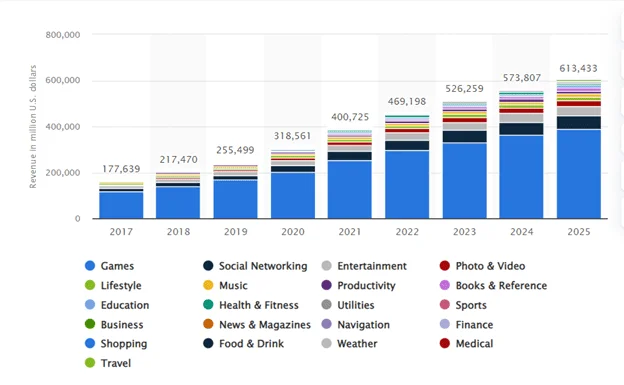Last Updated on March 12, 2024 by Nasir Hanif
Table of Contents
INTRODUCTION:
The sudden rise in innovations and uproar of digitalization has drastically changed our technological landscape. A good proportion of the present-day population is dependent on their mobiles for their every move. Global income from mobile applications will exceed 318 billion US dollars by 2020. Hence this section demands more innovations to reduce the bulky and complex applications from running slow. That is why we need frequent mobile testing. Statistics show there was an increase of more than 60 billion US dollars over 2019. The mobile gaming industry generated over 200 billion US dollars in sales that year, followed by social networking mobile applications, generating roughly 31 billion dollars.
Keeping all these in mind, we aim to create powerful applications which are more user-friendly and meet the increasing demands of consumers and clients. You also need an efficient mobile testing platform that enables actual devices or emulators to execute automated or manual testing on all apps, regardless of the operating system. TestIO, Appium, and Robotium are a few mobile testing tools that enhance the efficiency and performance of the applications.
Distribution of revenue generated by the sections
5 Tips to Improve Mobile Testing Skills
The five tips given below will help you improve your mobile testing skills.
1. Take Part in Testing Communities
Participating in testing and development groups is one of the best methods to keep up with the newest trends and emerging technologies. The Ministry of Testing Community is a lively, active, and healthy testing community that every tester should be a member of. This community’s primary communication channel is Slack, where testers from all across the globe exchange their knowledge about mobile testing and other related topics. Here you can get acquainted with professionals and know the best mobile testing tools for a particular problem.
Aside from the internet community, there are several software testing conferences where you may learn from other testers by attending seminars or hands-on workshops. During such meetings, much information gets frequently shared, and you get the opportunity to speak with the presenters afterward.
2. Invest your Time in Learning
Being a member of a testing community or attending a conference may not be sufficient for staying current. Official training courses like BBST, ISTQB, and others are accessible in the market. In these courses, every software tester may learn more about various testing approaches and effective mobile testing platforms. The training, however, can be costly and may not satisfy the demands of testers. There are other methods, known as mnemonics, for learning and remembering mobile testing strategies. Jonathan Kohl’s I SLICED UP FUN, and Daniel Knott’s MOBILE APP TESTING is the most well-known mobile testing heuristics. Both mnemonics are excellent for learning new mobile testing procedures and remembering them.
In addition to training, seminars, and mnemonics, you strongly recommend reading testing-related blogs online. There are multiple bloggers out there that freely share their knowledge.
3. Practise Honing Your Testing Skills
Getting formal training and reading about mobile testing is one way to improve. However, using mobile testing tools on real devices is the best and most successful approach to learning new skills. In this instance, I propose downloading and using various apps on a mobile device. Examine the UI to see whether it changes in different usage circumstances when using the apps. Consider whether an app works differently at various mobile network speeds, to mention two hypothetical areas where bugs might occur.
In addition, you can turn off the phone’s automatic app update. Before updating applications to the newest version, check the release notes to see whether the development team mentions any issue fixes. When such information is available, attempt to replicate the bug within the app. Taking notes on the processes and identifying the underlying problem (if possible) is best. This activity will help you develop fresh testing ideas and learn from the errors of others.
4. Build your very Own Testing Network
As previously stated, participation in online and offline groups is vital for learning. Every tester should begin creating their testing network while attending online and offline testing activities. Don’t be afraid to approach someone standing alone at a conference and strike up a discussion. It is amazing how simple it is to chat with other people, make personal connections, and establish a network of testers.
You may develop your testing abilities by gaining access to the newest technological trends or some mobile testing platform through your testing network, whether it is online or offline.
Last but not least, there are social networks where you may connect with software testers. The previously stated Ministry of Testing Slack channel is a fantastic place to start contacting testers. In addition, it is recommended that you follow various hashtags on Twitter, such as #MobileTesting or #SoftwareTesting, to follow individuals discussing the issues.
5. Use Community-Powered Tools
Hands-on testing activities are required for mobile real device testing. However, some operations can and should be automated so that the actions preceding each release are not repeated. As a result, mobile testers must be familiar with the many mobile testing tools available. Many open-source software testing frameworks have emerged on the market in recent years. Newer versions of a tool may offer unique opportunities to automate more and assist the entire software development team focus on difficulties rather than spending too much time on repetitive chores.
Individual developers or corporations building a community around the tools enhanced them over time, making them robust and powerful to use, and assisting other teams in developing and testing better products of higher quality.
CONCLUSION:
Mobile testing tools and platforms facilitate better mobile testing enhancing their quality. Joining the communities gives you the exposure to learn better, and you can hone your skills by discussing with your correspondences about real-life problems to come up with better solutions. The quality of any software product should always be prioritized. This is especially true for mobile goods, as users have far greater expectations of the software on their devices. For your company to keep up with the ever-changing mobile environment, testers must update their testing abilities at regular intervals. According to Statista’s Digital Market Outlook, sales will rise in most areas over the next few years, reaching roughly 613 billion US dollars by 2025.

Greatest challenges in mobile testing from 2013-2018
Apart from this, if you are interested to know more about How are Mobile app testing tools important then visit our Technology category.



























